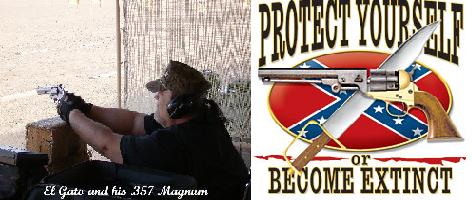
Above: A Russian Model 1891/30 sniper rifle with PE scope and socket bayonet. The Russians moderized the rifle in 1930 for more efficient production. This particular rifle has a turned-down bolt handle. The projection ahead of the trigger guard is the magazine for the 7.62x54R cartridges. The Russians intended for their troops to have their bayonets mounted on the rifle the majority of the time and, although scabbards for the bayonet existed, most of the time it was not issued. Peculiar to the Model 91/30 are the oval disks with slots that pass through the stock. These are the sling attachment points. The Russians used a cloth sling with leather loops on both ends that fed through the slots. This feature was retained on rifles made by China and other Warsaw Pact countries. China and Vietnam used this kind of sling on their Type 56 AK rifles and SKS carbines. These slings were very common on the weapons used by the VC/NVA during the Vietnam War.
The old M-N 1891 is a real war club, for certain. It's even been in a couple of Hollywood epics (as a sniper rifle) such as "Enemy at the Gates" -- the best German against the best Russian sniper at Stalingrad in WW2 -- and "Sniper 2" -- where Tom Berenger as the sniper duels with another sniper in some shot-up Balkans village.
As rifles go, the M-N is simple and strong. It's very appropriate for the average Russian conscript infantryman. It is not as finely finished nor as advanced as the German Model 98 Maurser -- the grandfather of all modern bolt actions -- because the '91 represents an earlier period of development in the bolt action saga. The action is not as strong as the Mauser's, nor does it have the safety features of the Mauser. It does not have the human engineering of the Model 98 Mauser. Nevertheless, the M-N is a major player among infantry rifles.
Some development trivia about smokeless powder. The M-N '91 was one of the first rifles to use smokeless powder cartridges by any major nation. Smokeless powder allowed higher velocities with better bullets and flatter shooting rifles to greater ranges. There was one drawback that was not easily solved. The primers used in the cartridges of the day contained a salt compound that caused barrels and chambers to rust and pit -- destroying the barrel before its time. All the major power's smokeless powder rifles had the same problem until the mid-1950s when the changeover to non-corrosive primer compounds was accomplished. Strangely, the Russians and Japanese were the ones to pioneer a solution for corrosive primers during the 1930's -- they started chrome plating the chambers and bores of rifles and machine guns. The plating made the barrels immune to the corrosive effects of the primers. WW2 made chromium a scare item and it was dropped from wartime guns out of necessity. However, once the war was over the Russians (later Chinese) went back to chrome plating the insides of their barrels. The other major powers lagged behind, believing this was too costly and unnecessary.
The Americans got into the barrel plating business by another door. We wanted to make aircraft machine gun barrels last longer and started plating the insides of our .50 and 20mm machine gun barrels. Eventually, some .50 aircraft barrels added a Stellite liner -- a diamond-hard insert -- for the chamber to prevent wear. The Russian/Chinese AKs and SKS rifles faced by American troops in Vietnam all had chromed barrels. NATO was the first to specify chromed barrel chambers and bores for its rifles. All American M14 rifle and M60 machine gun barrels were chromed from the beginning. However, the first M16 barrels were not chromed (thanks to McNamara's "whiz kids" at the Pentagon) and this contributed to the bad reputation of the first M16s used there. By mid-1969, all M16 barrels coming off the production lines had chrome plated chambers and barrels to survive in the abusive hot, humid Vietnamese climate. Today, vitrually all barrels for the military (up to and including cannons) have chromed chambers and barrels. The primary reason now is to increase barrel life, but the initial reason was to prevent corrosion caused by the old-time primer mixes.
 Free Forum Hosting
Free Forum Hosting